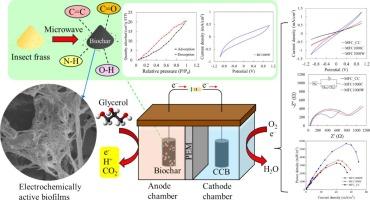微波转化的昆虫碎屑生物炭作为原油甘油动力微生物燃料电池的高性能阳极
IF 6.7
2区 工程技术
Q1 ENGINEERING, CHEMICAL
引用次数: 0
摘要
昆虫养殖规模的不断扩大导致产生了大量的杂草,尽管它具有资源回收的潜力,但往往被忽视。在这项研究中,我们开发了一种增值途径,通过微波辅助热解(MAP)将粉虫碎屑转化为电活性生物炭,为传统的热处理提供了一种快速、节能的替代方案。所得的生物炭具有丰富的氮和氧表面官能团,被用于制造微生物燃料电池(mfc)的新型阳极。电化学分析表明,map衍生电极具有优异的电荷转移性能(397.6 Ω)和高电容(0.29 F/g),显著优于传统热解电极。当集成到MFC处理粗甘油(生物柴油精炼的主要副产物)时,该系统在四天内实现了完全的底物去除(99.85%),峰值功率密度达到5678 mW/m2,比标准碳布阳极高出70%以上。微生物谱分析进一步表明,电活性微生物和甘油降解微生物在猪草基生物炭上的定殖增强。富壁菌门(Firmicutes)和脱硫菌门(Desulfobacterota)的富集增强了MFC1000W的电化学活性,有效降低了电荷传递电阻(452.9 Ω)。拟杆菌有助于各种外电的生长和加速电子转移。这项工作不仅为昆虫残渣的增值提供了一条可持续的途径,而且还展示了其在生物电化学系统中用于废物-能源转换的功能潜力。本文章由计算机程序翻译,如有差异,请以英文原文为准。

Microwave-converted insect frass biochar as a high-performance anode for crude glycerol-powered microbial fuel cells
The growing scale of insect farming has led to the generation of large volumes of frass, which is often overlooked despite its potential for resource recovery. In this study, we developed a value-added pathway by converting mealworm frass into electroactive biochar via microwave-assisted pyrolysis (MAP), offering a rapid, energy-efficient alternative to conventional thermal treatment. The resulting biochar, rich in nitrogen and oxygen surface functionalities, was used to fabricate a novel anode for microbial fuel cells (MFCs). Electrochemical analysis revealed that the MAP-derived electrode exhibited excellent charge transfer performance (397.6 Ω) and high capacitance (0.29 F/g), significantly outperforming its conventionally pyrolyzed counterpart. When integrated into an MFC treating crude glycerol—a major by-product of biodiesel refining—the system achieved complete substrate removal (99.85 %) within four days and reached a peak power density of 5678 mW/m2, outperforming standard carbon cloth anodes by over 70 %. Microbial profiling further indicated enhanced colonization of electroactive and glycerol-degrading microbes on the frass-based biochar. The enrichment of Firmicutes and Desulfobacterota enhanced the electrochemical activity of MFC1000W and effectively reduced the charge transfer resistance (452.9 Ω). Bacteroides contributed to the growth of various exoelectrogens and accelerated electron transfer. This work not only provides a sustainable route for insect frass valorization, but also demonstrates its functional potential in bioelectrochemical systems for waste-to-energy conversion.
求助全文
通过发布文献求助,成功后即可免费获取论文全文。
去求助
来源期刊

Journal of water process engineering
Biochemistry, Genetics and Molecular Biology-Biotechnology
CiteScore
10.70
自引率
8.60%
发文量
846
审稿时长
24 days
期刊介绍:
The Journal of Water Process Engineering aims to publish refereed, high-quality research papers with significant novelty and impact in all areas of the engineering of water and wastewater processing . Papers on advanced and novel treatment processes and technologies are particularly welcome. The Journal considers papers in areas such as nanotechnology and biotechnology applications in water, novel oxidation and separation processes, membrane processes (except those for desalination) , catalytic processes for the removal of water contaminants, sustainable processes, water reuse and recycling, water use and wastewater minimization, integrated/hybrid technology, process modeling of water treatment and novel treatment processes. Submissions on the subject of adsorbents, including standard measurements of adsorption kinetics and equilibrium will only be considered if there is a genuine case for novelty and contribution, for example highly novel, sustainable adsorbents and their use: papers on activated carbon-type materials derived from natural matter, or surfactant-modified clays and related minerals, would not fulfil this criterion. The Journal particularly welcomes contributions involving environmentally, economically and socially sustainable technology for water treatment, including those which are energy-efficient, with minimal or no chemical consumption, and capable of water recycling and reuse that minimizes the direct disposal of wastewater to the aquatic environment. Papers that describe novel ideas for solving issues related to water quality and availability are also welcome, as are those that show the transfer of techniques from other disciplines. The Journal will consider papers dealing with processes for various water matrices including drinking water (except desalination), domestic, urban and industrial wastewaters, in addition to their residues. It is expected that the journal will be of particular relevance to chemical and process engineers working in the field. The Journal welcomes Full Text papers, Short Communications, State-of-the-Art Reviews and Letters to Editors and Case Studies
 求助内容:
求助内容: 应助结果提醒方式:
应助结果提醒方式:


